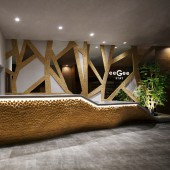eeGee Stay: Reviving the Local Economy Local Capsule Hotel by Hajime Tsuruta |
Home > Winners > #92518 |
 |
|
||||
| DESIGN DETAILS | |||||
| DESIGN NAME: eeGee Stay: Reviving the Local Economy PRIMARY FUNCTION: Local Capsule Hotel INSPIRATION: After World War II, shopping arcades were the main retail hubs in Japan. However, due to recent redevelopment and modernization in Japanese cities, huge suburban shopping malls have been drawing consumers away from the arcades, causing these old-fashioned shops to suffer. Many shops have already closed, and more are just waiting to shut down. Sometimes people call these shopping arcades "shutter streets" even though there are still many charming stores left behind. The driving motivation behind this renovation project was to attract new customers to a local shopping arcade, boosting the local economy. By producing a stripped-down capsule hotel without its own restaurant, cafe, or laundromat, this design pushes hotel customers back into the shopping arcade, where they will spend more money at local businesses. This design ultimately fosters a symbiotic relationship between the capsule hotel and its surrounding businesses. The visual design of this project was influenced by recent trends towards infusing natural features into urban areas. Discarding the boxy design of conventional capsule hotels, this project was conceived as a hidden forest within the shopping arcade. With an emphasis on wood and greenery, customers staying at this capsule hotel sleep nestled in private treehouses rather than in plastic boxes. UNIQUE PROPERTIES / PROJECT DESCRIPTION: In Japan both old buildings standing vacant and the economic decline of local shopping arcades have become major social problems. This capsule hotel was designed to address both issues while embracing sustainable, socially responsible design principles. Rather than building from the ground up, the hotel was constructed in an existing vacant building in order to better utilize resources. Utilizing an extant building also ensured that the exterior design of the hotel would fit in with the surrounding businesses. Furthermore, renovating extant buildings is a more cost-effective strategy than constructing a new building. Savings from these cost-cutting measures are passed on to the end user in the form of lower prices, making the hotel more attractive to consumers (particularly the money-conscious youth demographic). Although shopping arcades were the main retail hubs in postwar Japan, recent redevelopment has pulled consumers away from the shopping arcades and into contained shopping malls. This hotel was designed with an eye towards minimalism in order to encourage visitors to patronize local shops, ultimately reviving the local economy and preserving the shopping arcade. OPERATION / FLOW / INTERACTION: Although capsule hotels are popular in Japan, most designs rely heavily on plastics. These artificial facades can be unwelcoming to the customer. The organic appearance of our urban forest offers a more relaxing alternative: an oasis within the city where customers can rest. The sleeping cabins emphasize ergonomic design. Designers collaborated with a manufacturer to create a proprietary hotel mattress to support sleepers' posture. Cabin ladders are also designed to minimize strain on the body. PROJECT DURATION AND LOCATION: This wooden cabin hotel has opened on May.10th, 2019 in Saitama, Japan. FITS BEST INTO CATEGORY: Interior Space and Exhibition Design |
PRODUCTION / REALIZATION TECHNOLOGY: OSB boards were assembled to form the wooden box to sleep and made 154 boxes for women, 152 boxes for men. SPECIFICATIONS / TECHNICAL PROPERTIES: construction classification:Build TAGS: nature, hotel, cabin, renovation, wooden RESEARCH ABSTRACT: After researching other hotels to determine what features were considered most desirable by consumers, designers scouted shopping arcades on foot to find their location. The design team settled on the Ichiban-gai shopping arcade near Oomiya station. The team met with the local business bureau and managers of Ichiban-gai shops to discuss their plans. This allowed the designers to determine which businesses within Ichiban-gai would best supplement the hotel's lack of built-in amenities. CHALLENGE: A major challenge during the design process was designing and assembling the offset sleeping cabins. Cabins in higher and lower positions alternate along the walls of the hotel, and the interior shape features a step which creates an irregular ceiling in lower cabins. The cabins were originally manufactured in an offsite laboratory, requiring designers to be particularly precise in their measurements. When the cabins were assembled at the renovation site, a measurement error was discovered. The horizontal measurements of the cabins were slightly too large, and they did not fit into the existing building. The first run of cabins had to be reconstructed due to this error, delaying project completion by a week. ADDED DATE: 2019-09-27 21:37:29 TEAM MEMBERS (1) : Hamatomo Kanko:Reiko Ogawa IMAGE CREDITS: Non |
||||
| Visit the following page to learn more: https://www.nrcgroup.co.jp/ | |||||
| AWARD DETAILS | |
 |
Eegee Stay: Reviving The Local Economy Local Capsule Hotel by Hajime Tsuruta is Winner in Interior Space and Exhibition Design Category, 2019 - 2020.· Read the interview with designer Hajime Tsuruta for design eeGee Stay: Reviving the Local Economy here.· Press Members: Login or Register to request an exclusive interview with Hajime Tsuruta. · Click here to register inorder to view the profile and other works by Hajime Tsuruta. |
| SOCIAL |
| + Add to Likes / Favorites | Send to My Email | Comment | Testimonials | View Press-Release | Press Kit |
Did you like Hajime Tsuruta's Interior Design?
You will most likely enjoy other award winning interior design as well.
Click here to view more Award Winning Interior Design.








